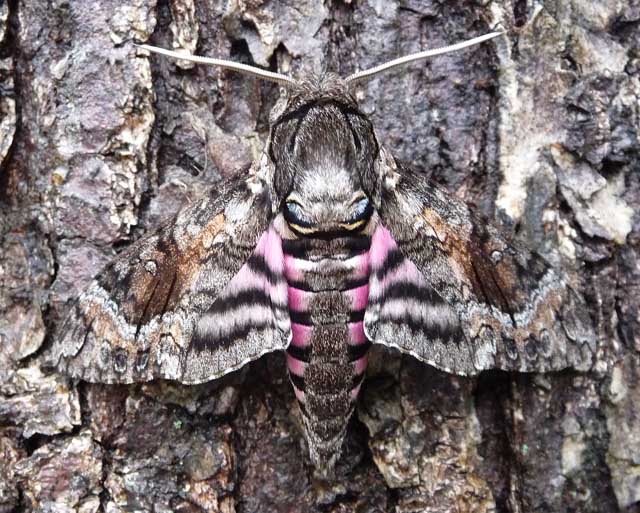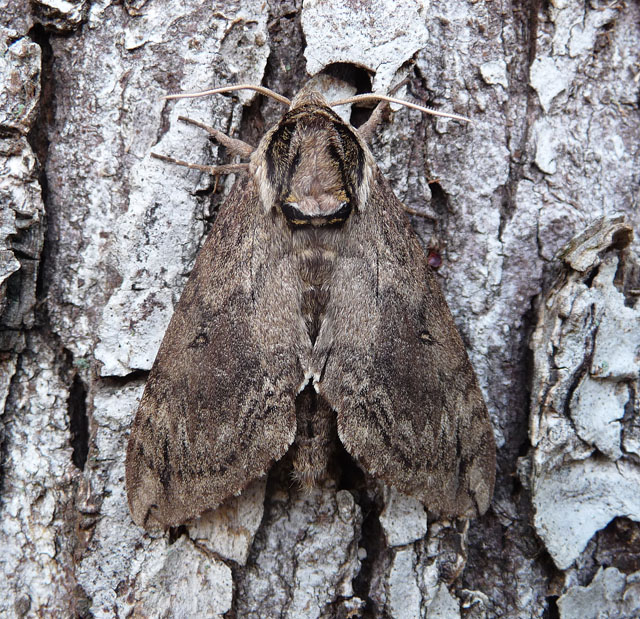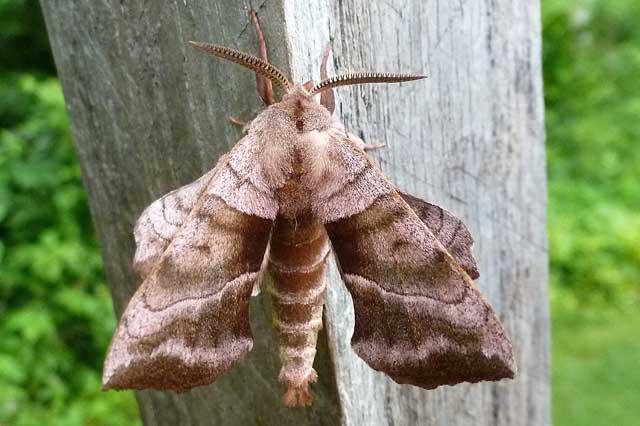Sphinginae subfamily
Sphingini tribe:
 |
Agrius cingulata
BAMONA/DM,
Pink-spotted Hawkmoth
late summer to fall stray
This species is a strong migrant and adults nectar from deep-throated
flowers including moonflower (Calonyction aculeatum), morning glory
(Convolvulus), honey suckle (Lonicera) and petunia (Petunia species).
|
Agrius cingulata, Old Bridge, September 9, 2011, David Moskowitz.
 |
Ceratomia amyntor
WO,
the Elm Sphinx or Four-horned Sphinx
The upperside of the forewing is brown with dark brown and white
markings including a white costal area near the wing base, dark
streaks along the veins, and a white spot in the cell.
Larvae feed on Elm (Ulmus), birch (Betula), basswood (Tilia), and
cherry (Prunus). |
 |
The upperside of the forewing is yellowish brown with no white
markings, but there are indistinct black lines and dashes. The cell
spot is gray with a black outline and the upperside of the hindwing
is yellowish brown with obscure lines. |
Ceratomia catalpae, Old Bridge, Middlesex County, New Jersey, September 9, 2011, David Moskowitz.
 |
The upperside of the forewing is pale brownish gray with wavy
black and white lines and a black-outlined white cell spot.
|
 |
The upperside of the forewing is dark brown with a dusting of white
scales. Some moths have patches of reddish or yellowish brown on the
wings.
|
 |
The upperside of the forewing is gray with heavy black bands. The
upperside of the hindwing is brownish gray with no markings.
|
 |
The upperside is of the forewing is gray with two (sometimes one or
three) black dashes near the wing center; other markings are usually
diffuse. |
 |
The upperside of the forewing is gray-brown with wavy lines, black
dashes, and one or two small white spots near the center of the
costa. |
 |
The upperside of forewing is gray to grayish brown with a black line
running from the middle of the costa to the middle of the outer
margin; the line may be broken near the margin. There is a splash of
brown around the cell spot.
|
 |
The moth abdomen usually has five but sometimes six pairs of yellow
bands. The upperside of the forewing is blurry brown and gray.
|
 |
The abdomen of the adult moth has three pairs of yellow spots. The
upperside of the forewing is yellowish brown to deep chocolate
brown with a dusting of white scales and zigzagged black and
white lines.
|
 |
The abdomen usually has six pairs of yellow bands, broken across the
back. The sixth set of markings is quite small.
The upperside of the forewing has indistinct black, brown, and
white markings.
|
 | The upperside of the forewing is gray with indistinct black and
white markings. There is a series of black dashes
from the base to the tip, and a small white cell spot.
|
 |
Sphinx chersis
WO,
the Northern Ash Sphinx or Great Ash Sphinx
The upperside of the forewing is soft dark gray to blue-gray with
a series of black dashes, one of which reaches the wing tip.
|
 |
Sphinx drupiferarum larvae hide in the day and feed
primarily on cherry, plum, and apple at night. |
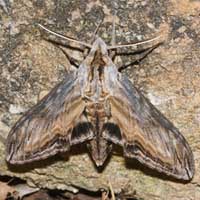 |
The outer margins of the forewings are slightly concave in the
male, but not in the female. The costal half of the forewings are
grey, but the posterior portion is a distinctive warm
yellowish-brown; the boundary between these two areas is marked
with a series of dark diagonal streaks.
|
 |
The upperside of the forewing ranges from brown with black borders
through brownish gray with paler borders to pale gray with no
borders. Dashes, submarginal line, and cell spot are usually weak.
|
 |
The lower forewings are predominantly brownish-yellow with a fairly
wide dark bar along the inner margin. At rest the wings hug the body,
giving the moth a long slender look.
|
Sphinx kalmiae, Old Bridge, May 17, 2012, David Moskowitz
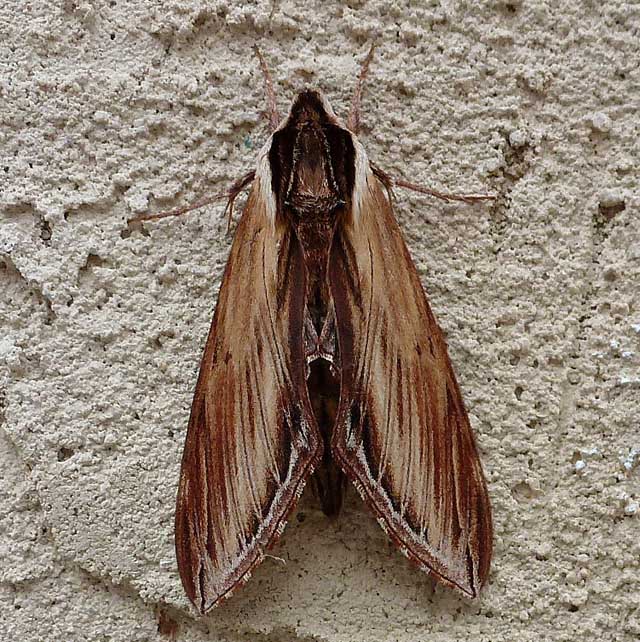
Sphinx kalmiae, Old Bridge, Middlesex County, New Jersey, May 17, 2012, David Moskowitz
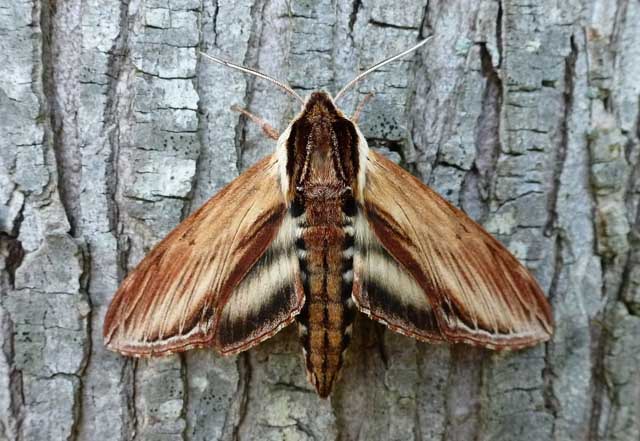
Sphinx kalmiae, Old Bridge, Middlesex County, New Jersey, May 17, 2012, David Moskowitz
Smerinthini Tribe:
 |
The adults are also highly variable; sometimes wings of an individual
may be all one color or may have several colors, ranging from pale to
dark brown, and may have a white or pink tinge.
See the file for the female; she is different. |
Amorpha juglandis, Old Bridge, June 11, 2012, David Moskowitz
 |
Pachysphinx modesta
WO,
the Modest Sphinx or Poplar Sphinx
This moth has a large, heavy body, and females can be remarkably plump.
Larvae are fond
of poplars and
willows. |
 |
This appears to be an uncommon species. Blueberry and
huckleberry (Vaccinium), cherries (Prunus) and willows (Salix) are
the favorites as larval foodplants.
|
 |
Named for the dull grey-blue spot (minus dark pupil) in the hindwing,
this moth has a wide distribution and is common in Burlington
County.
I regularly see them on Prince Edward Island, and they are reported
as far south as Florida.
|
 |
Paonias myops
WO/DM,
the Small-eyed Sphinx
Named for the small eye-spot in the hindwing, this moth has a wide distribution
and is common in Burlington County.
I regularly see them on Prince Edward Island, and they are reported
as far south as Florida.
|
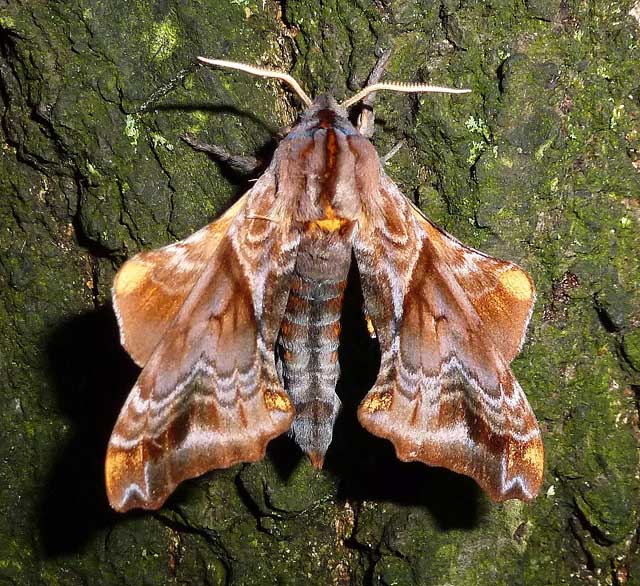
Paonias myops male, East Brunswick, May 26, 2012, David Moskowitz
 |
This moth is widely distributed and fairly common.
Along the East Coast, it flies from P.E.I. to Florida.
|
Macroglossinae subfamily
Dilophonotini tribe:
See Hemaris comparison to help distinguish the next three species.
 |
Hemaris thysbe
BAMONA,
the Hummingbird Clearwing
It is not difficult to see why many gardeners would mistake an
Hemaris thysbe moth for a small hummingbird as it hovers, sipping
nectar from flowers through a long feeding tube.
|
 |
Hemaris diffinis
WO,
the Snowberry Clearwing or Bumblebee Moth
Adults mimic bumblebees and are quite variable. The wings are
basically clear, with dark brown to brownish-orange veins, bases and
edges. The thorax is golden-brown to dark greenish-brown.
|
 |
Hemaris gracilis
WO,
the Slender Clearwing or Graceful Clearwing
Hemaris gracilis is distinguished from similar species by a pair of
red-brown bands on the undersides of the thorax, which varies from
green to yellow-green dorsally and sometimes brown with white
underneath. They have a red abdomen.
|
Philampelini tribe:
 |
Adults nectar from flowers of Japanese honeysuckle
(Lonicera japonica), petunia (Petunia hybrida), mock orange
(Philadelphus coronarius), and phlox (Phlox).
Note the differences between this moth and the Pandorus Sphinx.
|
 |
If you have Grape or Virginia Creeper nearby, then you probably have
this species.
|
Macroglossini tribe:
 |
This day flier is widely distributed. If you have Virginia Creeper,
you probably have the Nessus Sphinx. It is reported from
Burlington.
Two bright, distinct, narrow yellow
bands are often visible on the abdomen.
|
 |
They are common in New Jersey and common
here on Prince Edward Island.
You will often see this species listed as Darapsa pholus,
especially in older literature.
They are probably common
in Burlington County.
|
 |
Darapsa myron
BAMONA,
the Virginia Creeper Sphinx or the Grapevine Sphinx
The forewing upperside is dark brown to pale yellowish gray, with an
olive tint. This species was quite common in rural New Jersey where
the forewing color contained more green than described above.
|
 |
The forewing upperside is often greenish brown (photo to right) with
curved dark lines and pinkish-white patches.
|
 |
The moth's outer margin of the forewing is deeply scalloped.
The upperside is light brown with dark brown markings.
There is a small black and white spot near the tip.
The upperside of the hindwing is orange-brown with a dark brown outer margin and median line.
|
 |
Hyles lineata
WO,
the White-lined Sphinx
The forewing upperside is dark olive brown with paler brown along the
costa and outer margin, a narrow tan band running from the wing tip
to the base, and white streaks along the veins.
|
 |
This moth is very much under reported across the United States. It
is a rapid day flier so is probably not in too many collections.
Grape is a popular larval host.
|
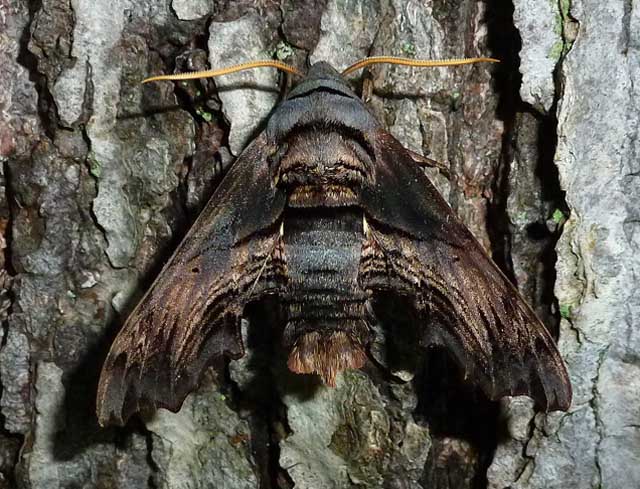
Sphecodina abbottii, Old Bridge, May 23, 2012, David Moskowitz.
 |
The upperside of the forewing is pale brown with lavender-gray at the
base and has dark brown lengthwise lines throughout. The upperside of
the hindwing is dark brown with a band of whitish, wedge-shaped
marks.
|
|
|
